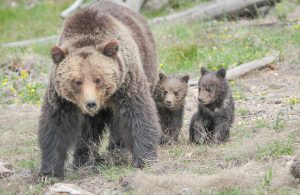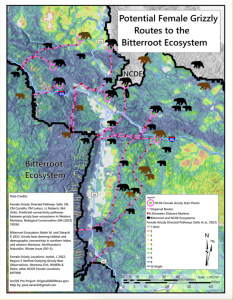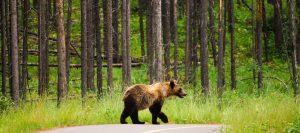Back in 1975, grizzly bears were among the very first animals to be listed under the newly enacted Endangered Species Act (ESA). Other species that benefitted immediately from the watershed legislation were the bald eagle, the Florida manatee and the American alligator. The ESA was designed for dire conservation circumstances—a lifeline to prevent extinction of a species and foster recovery of those animals. At the time of listing, it was believed that only 136 grizzly bears roamed freely in the few remaining wild, remote sections of the lower 48 states. It is estimated that over 50,000 grizzlies lived in the West prior to European settlement.
The US Fish and Wildlife Service (USFWS) was ultimately tasked with establishing a recovery plan for grizzlies as part of the ESA process. In 1993, the agency identified six regions of the western United States where recovery of grizzlies would be focused. These six recovery areas were chosen because grizzly bears were either still present or the recovery area is capable of supporting a significant population of bears. Thanks to effective ESA protections, grizzly bears now occupy a high percentage of habitat in two of the six recovery zones—the Greater Yellowstone Ecosystem (GYE) and the North Continental Divide Ecosystem (NCDE).
Unfortunately, it’s a far different story in the wilds of the Bitterroot Recovery Zone, which essentially aligns with the Selway-Bitterroot and Frank Church-River of No Return Wilderness Areas. The Bitterroots are Idaho’s unclaimed crown jewel of grizzly bear habitat: historic grizzly country, abundant food, secure habitat, and 6,000 square miles of wild lands for bears to roam. Research has shown that the area could support 300 grizzlies. Unfortunately, the lack of connectivity with other grizzly bear populations to date has made it difficult for bears to return to this large section of their historic range. The last reproductive female died there over 80 years ago.

As a keystone species, grizzly bears would make the Bitterroots whole again and restore a part of Idaho’s natural heritage to the heart of the state.
Last year, in a Montana courtroom, Judge Donald Molloy signaled that taking no action to recover grizzly bears was no longer acceptable and directed the USFWS to revisit their 20-year-old plan to restore grizzlies in the Bitterroot Ecosystem (BE).
The agency is now at the very beginning of a process to involve the public and gather new science as it writes a new Environmental Impact Statement (EIS) and takes a “fresh look at a strategy for supporting restoration of grizzly bears in the BE.” The conservation goal is for the area to host a population of grizzlies that’s well distributed, self-sustaining, and protected well enough to maintain long-term “viability and connectivity (to other populations).”
It’s also important to note that this effort is entirely separate from other ongoing evaluations by USFWS about whether or not to delist Yellowstone grizzlies.
Initial public meetings just concluded with the USFWS describing a range of possible alternatives to restore grizzlies in the Bitterroot, including:
- Active reintroduction: Establish a breeding population of Bitterroot bears by capturing animals from other populations for release into the Bitterroots.
- Natural recolonization: Obligates the USFWS to take specific management efforts (to be outlined in a Draft Environmental Impact Statement) so that bears eventually establish breeding populations in the Bitterroots after having dispersed naturally from other populations—most likely the North Continental Divide and Yellowstone Ecosystems.
- Actions to facilitate connectivity: Obligates the USFWS to take specific conservation measures (to be outlined in an Environmental Impact Statement), to ensure that individual bears and/or family units have adequate corridors to move between important landscapes to fulfill their life history needs.
- No action: no change from a current management direction or level of management intensity.
The Idaho Conservation League is heartened that the USFWS is renewing efforts to restore grizzly bears in this large unoccupied swath of important core habitat. We’re also eager to see the public engage during this historic opportunity and help shape wildlife conservation efforts on public lands in Idaho. 
ICL believes that a combination of “natural recolonization” and “connectivity” alternatives (currently presented as Actions #2 and #3) offers the best approach to restoring grizzlies in the Bitterroot.
Recent research indicates that, if trends continue and natural recovery is supported by the USFWS and other stakeholders, female grizzly bears could reach some habitat in the Bitterroots in as few as 4-5 years. We also know that if naturally cautious females move into that habitat, the males will find them and help to “anchor” a population in that area. For this reason, the USFWS needs to maintain the conservation status of Bitterroot grizzlies as “threatened.” While moving a population of bears into the Bitterroots would likely happen more quickly than natural recovery, the “active reintroduction” alternative would create an “experimental, nonessential” population of bears (known as “10(j)”) that would receive fewer ESA protections and potentially be subject to higher levels of human-caused mortality. ICL believes that active reintroduction should only be pursued as a last resort if long-term monitoring shows females are not occupying and reproducing in the Bitterroots naturally.
ICL encourages wildlife supporters to speak up for native grizzly bears by taking action below and send their scoping comments to the USFWS ahead of the March 18th deadline. Urge the agency to adopt blended approaches described in Actions #2 and #3 and to also account for other biological and socio-economic factors that would make their Environmental Impact Statement and recovery plan even more effective.
Want to go another extra mile for Bitterroot grizzlies? Please consider including some of these specific actions (that are part of a blended “natural recovery” alternative) in your comments to USFWS:
Habitat and Connectivity
- Use the best available science relating to habitat and other life history needs of grizzlies, including the potential effects of climate change on denning habitat. This science should cover habitat restoration standards for large carnivores, connectivity measures, wildlife management, and public lands policy.
- Define the Bitterroot recovery zone by combining the proposed boundaries in the 1996 Recovery Plan and the 2000 EIS to provide the greatest opportunity for connectivity between the Bitterroot and other core populations.
- Collaborate with state and federal agencies, Tribes, and NGOs to ensure highway passage structures (overpass/underpasses) facilitate linkages between the Bitterroot and grizzly populations in the NCDE, Greater Yellowstone, and Selkirk/Cabinet-Yaak Recovery Zones. These passageways would also benefit other wildlife such as elk, moose, and mule deer and improve public safety.
- Avoid harmful large-scale industrial development in areas important for grizzly bear connectivity to the Bitterroot.

Forest Service and public land management
- The Forest Service should ensure that grizzly bear core habitat and corridors are not fragmented by too many roads. The Forest Service should adopt wildlife-friendly amendments to Forest Plans to support grizzly bear connectivity and conservation now and into the future.
Idaho Department of Fish and Game Trapping and Hunting regulations
- The Idaho Department of Fish and Game should make sure that trapping and hunting practices (snaring, baiting, hunting with hounds, etc.) for other species such as black bear, wolf, mountain lion, marten, and coyote do not hamper grizzly bear restoration efforts.
- The Idaho Department of Fish and Game should make sure that hunter education classes teach hunters how to tell the difference between grizzly bears and black bears.
Conflict Management and Community Education (Local, State and Federal partners)
- Compare current ecological, economic, and social values with the values of recovered grizzly bears and other native species
- Work with state agencies to expand community education programs and food storage policies to avoid human-grizzly bear conflicts.
- Work with federal/state agencies and livestock producers to expand programs that focus on nonlethal methods to avoid conflict.
- Develop contingency plans for conflicts that allow for bears to be relocated within the Bitterroots.
Recreation and Grazing (Local, State and Federal partners)
- Analyze impacts of motorized and non-motorized winter travel in grizzly denning habitat
- Analyze existing livestock grazing allotments and evaluate conservation opportunities to keep ranchers whole such as voluntary grazing lease buyouts.
Grizzly bear populations have the capacity to rebound. The Endangered Species Act eliminated historic sources of human-caused mortality, such as indiscriminate hunting and other fear-based eradication efforts. Legal protections and safeguards in high-quality core habitat have allowed grizzly bears to reoccupy significant parts of the Northern Continental Divide and Greater Yellowstone Ecosystem recovery zones. Now, the next chapter of grizzly bear conservation in the lower 48 states is up to us.
We have a once-in-a-lifetime opportunity to bring our grizzly bears back to the wild heart of Idaho. That’s what the bears deserve.
Please let the USFWS know how important it is to restore grizzlies in the Bitterroot by taking action below. Be sure to mention any specific experiences you have had in the Bitterroots or with grizzly bears that can keep the momentum for grizzly bears going. The comment deadline is March 18th!
